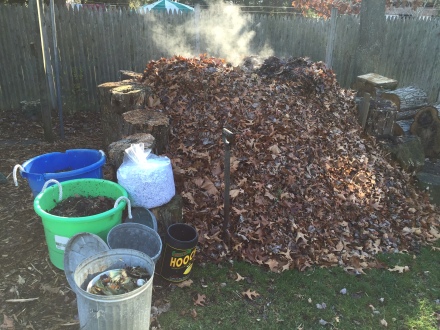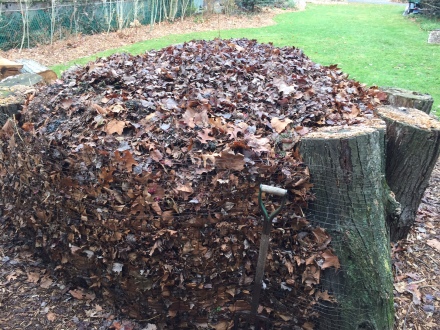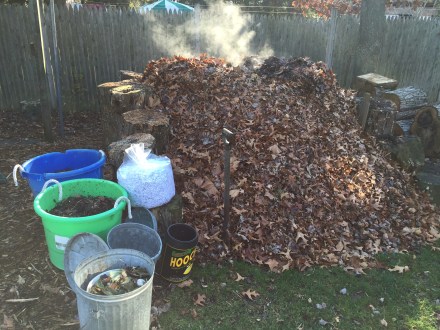Here in southern Connecticut in early December, leaf season has peaked and passed. The yards around town have, mostly, been swept clean of fallen leaves, giving way to the bleaker, bare-bones look of early winter.
Each morning the yellowing blades of grass in my lawn are etched with hoar frost and crinkle underneath my footsteps as I venture out with the dog to walk the property.
My pile, a week ago crowned higher than my head with the last big crush of swept-up leaves and gathered seaweed, continues to settle in upon itself, exhaling nightly as it assumes a more graceful angle of repose. The crystalline morning dew sweeps up the front flank from the cold ground to melt away as wisps of steam vapor waft into the ether from the soggy, saggy top.
My pile is never done. It is, by definition, a work in progress, and I am never done with it. Today, as soon as the morning warms, I will top off my pile with the remaining leftovers from the holiday just past. My pile is more than a match for all that we create and consume.
I read in “Improving Your Soil – a Practical Guide to Soil Management for the Serious Home Gardener” by Keith Reid (Firefly Books, 2014) that “For every 100 pounds of fresh organic material added, a mere 1 to 2 pounds end up as humus.”
I’m fascinated by the disappearing act that is my pile, and Reid has the scientist chops to explain what’s going on underneath the surface:
“Every time you mix pea vines or carrot tops into the soil, you unleash a cascade of biological activity. Insects, mites, snails and earthworms begin tearing the plant material into pieces as they eat their fill, creating residues that smaller organisms can access more easily. Fungal hyphae begin growing through the leaves and stems, excreting enzymes that digest the tough cell walls. Bacteria and other microorganisms colonize the exposed surfaces, absorbing the nutrients that have been released for the plants’ growth and activity. All these organisms convert carbohydrates into more organisms, while some is respired as carbon dioxide and returned to the air.
This growing population of fungi, bacteria and other organisms attracts the nematodes and protozoa that graze on this bounty to support their growth. They, in turn, are eaten by other organisms. As these creatures excrete waste products or die, they are cycled through more bacteria and fungi. At each cycle, some of the easily digested organic material is respired and lost, while the most resistant materials gradually accumulate. Eventually, only the toughest material remains – the black substance we know as humus—but it represents just a tiny proportion of what was originally added to the soil.”
To be fair, Reid is ambivalent about the value of composting versus adding raw organic material straight into the soil:
“I am a bit of a skeptic about compost and the suggestion that it is a magical solution to all our garden problems.
“There are lots of advantages to composting. The materials produced through the composting process are much easier to handle and mix with soil … nutrients are stabilized in forms that are slowly released in the soil.
“Composting is essentially accelerated rotting, [and] logic dictates that since it is the fungal hyphae and bacterial slimes produced during decomposition that help create a stable soil structure, there is a greater benefit to having decomposition occur in the soil. With composting, most of the biological activity happens outside the soil environment. But if the choice is between composting your old pea vines and returning them to the soil or leaving them on the curb for the garbage truck, I vote for composting!”
Composting has my vote, and although I “grasscycle” much of my grass clippings and mulch many a fallen leaf back into the ground as I mow, I grow weary of having to sweep and vacuum up all the flecks of such litter I track into my kitchen and onto my carpets. Besides, my life and garden would be much poorer without the ongoing backyard science experience that is my pile.
So I will keep stuffing the ballot box that is my pile with the raw organic material that it likes best and that I have on hand. I have two more buckets full of pungent seaweed gleaned from the nearby seashore; another plump plastic bag of shredded office paper, and a small bucket of scraps from my kitchen.

The bottomless (or topless) pit of my pile, ready to receive more leftovers from the kitchen, office and nearby sea.
I skirt the old wood stockade fence along the backside of my property to check on the bigger metal ash can my neighbors keep outside the back door to their kitchen and find the lady of the house stuffing it full with the last of the Thanksgiving leftovers. She has a spare plastic bag packed with the soggy sheaves of newspaper from their rabbit’s cage; she begins to apologize for her youngest daughter being so neglectful of late in cleaning the hutch, but I am happy to take the load off her hands.
I glance toward the back of their small, fence-in yard to notice a low ridgeline of leaves raked just far enough away from their picnic table to be out of the way. She’s diligent in keeping her front yard tidy, and through the fall has swept up her leaves into piles for me to drag over to my pile with a bed sheet, but has yet to tackle the backyard. She knows that on through the winter I will help finish the task, as my pile is like the bear in the storybook and always wants more.
My gleanings assembled, I take the wide-tined hay pitchfork and, turning it upside down, tease the top of my pile from the center to the edges, releasing billows of steam vapor from the dank mix of whole and chopped leaves. Into this newly formed caldera I scatter the bright white office paper, then chuck the upturned plastic bucket full of kitchen scraps from next door. I gingerly tease the rabbit-hutch mess from its plastic bag, and use the tip of the pitchfork to separate the soggy, urine-soaked newsprint. The value of the bunny’s contributions to my pile far outweigh my squeamishness in handling the mess, but just the same, I cover it up with a thin layer of leaves raked up from the front of my pile.
The buckets of seaweed are next, and I stick the pitchfork into the mix to dredge up a tangle of sand- and shell-flecked rotting lettuce from the sea and sprinkle it across the leaves. I always like to stop to examine the flotsam. There must have been a mass molt among the crabs, for this batch is suffused with their carapaces.
I finish by taking up the four corners of the bedsheet full of damp maple leaves and, stepping up along the top of one of the log walls that frame my pile, drag the sack up and unfurl the groaning load across the top.
My pile, newly suffused with a fresh load of raw organic material, has returned to mounded form, and underneath its new cloak of old leaves, will continue the unseen magic of its transformation into something much less, and much more.

What looks like a big ol’ pile of dead brown leaves actually conceals a riot of “accelerated rot.”


Thanks for the inspiration and instructions. I just started following you and have started my own pile here on the left coast where the leaves are still falling and the grass grows year round. I’m thrilled to not put out as many green buckets for pick up, and hope to not have to buy soil for my garden.
LikeLike
Pingback: My Pile: Topping Off | My Pile – WORLD ORGANIC NEWS